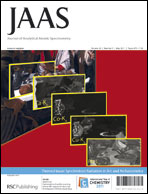Further metallurgical analyses on silver coins of Trajan (AD 98–117)†
Abstract
Within an interdisciplinary project, preliminary results of which were published in 2007, a group of 65 silver coins (denarii) of Trajan, evenly distributed over the entire span of his reign (2nd to 6th consulate), as well as 3 coins from the reign of his predecessor, the emperor Nerva (AD 96–98), had been acquired on the coin market. These pieces could be cross-sectioned in order to carry out analyses. Measurements were performed with μ-XRF and μ-SRXRF to check the fineness of the denarius alloy as well as to investigate if the coins of the different consulates showed distinct traits concerning the main impurities which could suggest a change of ore sources. Furthermore, it was examined whether the influx of precious metals into the Roman treasury after Trajan's Dacian campaigns (AD 101/102 and 105/106) could have had any repercussions on the composition of the denarius alloy; comparative data was provided by the analysis of nine imitations of Roman Republican denarii presumably struck in Dacia. Documentation of the cross-sections was performed with SEM/EDX in order to clarify details concerning the specific microstructure of the coins. An enrichment of Ag of approx. 100 to 200 μm in the near surface regions of most of the coins could be observed, which is due to corrosion effects. Previous metallographic analyses done by several scholars had been inadequate to clarify the central numismatic and economic questions. With the presented analyses, it was possible to correct the results of the earlier research and to provide, for the first time, a secure basis of data for the investigation of the development of the silver alloy used for denarii in Trajan's reign.

- This article is part of the themed collection: Synchrotron Radiation in Art and Archaeology

 Please wait while we load your content...
Please wait while we load your content...